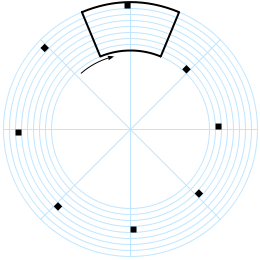Nipkow Scanning Disk: Difference between revisions
No edit summary |
No edit summary |
||
| (2 intermediate revisions by 2 users not shown) | |||
| Line 1: | Line 1: | ||
== The Nipkow Scanning Disk | == The Nipkow Scanning Disk == | ||
[[Image:Nipkow_disk.png|thumb|right|Schematic diagram of a Nipkow disk]] | |||
<p>Inspired by the telegraph and photography, many 19th century inventors sought ways to capture, transmit, and view images by electricity. One of the most influential inventors was Paul Nipkow (1860-1940), who in 1884 proposed a striking new way to translate a visual image into an electrical signal. </p> | |||
<p>Nipkow broke up an image into tiny bits by using a rotating "scanning disk." The disk had a spiral of holes bored into it. When the disk rotated, the holes would sweep over the whole image from top to bottom, slicing the image into 18 columns of information. Behind the disk were selenium photocells, which reacted to the light passing through the disk. The light from each of the 18 slices was converted to a varying electric signal in the photocell, and that signal was then transmitted to a distant receiver. At the receiver, incoming information was reassembled into a crude picture. The flow of electricity from the transmitter varied the brightness of a light bulb, the light of which was projected through another rotating Nipkow disk onto a screen. </p> | |||
< | <p>Later inventors, [[John Logie Baird|John Logie Baird]] and Charles F. Jenkins, retained the principle of the scanning disk, but employed electronic amplifiers and other inventions to improve the system. With the advent of "all electronic" [[Television|TV]], the disk disappeared, but the concept of chopping up an image into single picture elements and transmitting them in succession is retained even today in modern television, videotape, and digital imaging systems</p> | ||
[[Category:Communications]] [[Category:Communication_equipment]] [[Category:Video_equipment]] [[Category: | [[Category:Communications]] | ||
[[Category:Communication_equipment]] | |||
[[Category:Video_equipment]] | |||
[[Category:Imaging]] | |||
[[Category:Cameras_&_photography]] | |||
[[Category:News]] | |||
[[Category:Signals]] | |||
Revision as of 17:00, 10 February 2012
The Nipkow Scanning Disk
Inspired by the telegraph and photography, many 19th century inventors sought ways to capture, transmit, and view images by electricity. One of the most influential inventors was Paul Nipkow (1860-1940), who in 1884 proposed a striking new way to translate a visual image into an electrical signal.
Nipkow broke up an image into tiny bits by using a rotating "scanning disk." The disk had a spiral of holes bored into it. When the disk rotated, the holes would sweep over the whole image from top to bottom, slicing the image into 18 columns of information. Behind the disk were selenium photocells, which reacted to the light passing through the disk. The light from each of the 18 slices was converted to a varying electric signal in the photocell, and that signal was then transmitted to a distant receiver. At the receiver, incoming information was reassembled into a crude picture. The flow of electricity from the transmitter varied the brightness of a light bulb, the light of which was projected through another rotating Nipkow disk onto a screen.
Later inventors, John Logie Baird and Charles F. Jenkins, retained the principle of the scanning disk, but employed electronic amplifiers and other inventions to improve the system. With the advent of "all electronic" TV, the disk disappeared, but the concept of chopping up an image into single picture elements and transmitting them in succession is retained even today in modern television, videotape, and digital imaging systems
